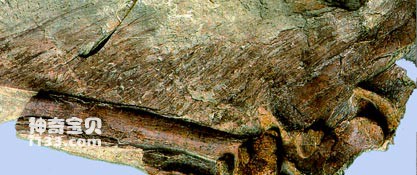Another theropod dinosaur produced in the lower part of the Yixian Formation is the unexpected Beipiaoosaurus. Its discovery was as unexpected as its species name. In 1997, Mr. Li Yinxian from the Fossil Management Office of Beipiao City donated a pile of relatively fragmented fossils to the Institute of Vertebrate Paleontology and Paleoanthropology, Chinese Academy of Sciences. At that time, no one expected that such a pile of seemingly insignificant fragmented fossils would actually " The "Golden Phoenix" flew out. After careful and detailed research, researcher Associate Professor Xu Xing found that it was a new and important member of the therizinosaur superfamily.

Accidental Beipiao Dragon
Due to the very peculiar morphology of therizinosaurs, paleontologists have been debating the systematic classification of these animals within the dinosaur family. The unexpected discovery of Beipiaoosaurus shows that therizinosaurs are a very specialized group among carnivorous dinosaurs. In addition, Beipiaoosaurus accidentally preserved filamentous skin derivatives similar to Sinosauropteryx, indicating that this filamentous skin derivative may have grown on many theropod dinosaur types, and it represents the later appearance of The early stages of bird feather evolution.

Millennium Chinese Bird Dragon
The discovery of Millennium Sinornithosaurus, the fifth dinosaur from the lower part of the Yixian Formation, is even more dramatic. In the summer of 1998, the western Liaoning field team of the Institute of Vertebrate Paleontology and Paleoanthropology, Chinese Academy of Sciences, unearthed the true specimen of this dinosaur near the fossil site of "Sinosauropteryx" on the last day before closing the team. Millennium Sinornithosaurus belongs to the theropod Dromaeosauridae. Dromaeosaur dinosaurs are of special significance in the study of the origin of birds.
In the 1970s, Professor Ostrom of Yale University, an internationally renowned paleontologist, resurrected the hypothesis that birds originated from theropod dinosaurs by studying a dromaeosaur fossil found in the early Cretaceous strata of North America. , has been widely recognized in the paleontological community. However, due to the limitations of fossil materials, there have been many misunderstandings about the anatomy of dromaeosaurs in the past. Therefore, this hypothesis has been attacked by reactionaries in some quarters.
The discovery of Millennium Sinornithosaurus provides more reliable material for the detailed study of the anatomy of dromaeosaurs. Preliminary research proves that dromaeosaurs are very close to early birds in morphology. The shape of the bones behind the head is very different from that of most dinosaurs. Instead, it has many characteristics of early birds. Its shoulder straps (connecting the forelimbs and The skeletal structure of the vertebrae is almost the same as that of Archaeopteryx. Although Millennium Sinornithosaurus cannot fly, its skeletal structure has undergone a series of evolutions that can adapt to flight. The skeletal system has fully met the requirements for flapping its forelimbs, which is a typical pre-evolutionary model. Millennium Sinornithosaurus also developed filamentous skin derivatives, further proving the widespread existence of this structure in non-avian theropod dinosaurs and providing important insights into the origin and evolution of feathers.
So far, several theropod dinosaurs discovered in the lower strata of the Yixian Formation in western Liaoning have skin derivatives similar to bird downs or feathers. This is the first time similar structures have been found in a group of organisms other than birds. The conclusion of the phylogenetic analysis and the study of the growth status of skin derivatives in these animals indicate that the filamentous skin derivatives found in therizinosaurs and compsognathids represent the primary stage of the evolution to feathers, and the origin of feathers is likely to be From then on, it gradually evolved into more complex body feathers. Among theropod dinosaurs, symmetrical feathers with pinnae were probably developed during the evolutionary stage of maniraptorosaurs. As for the asymmetrical "advanced" feathers with pinnae, they did not appear until after the origin of birds, and their function was obviously to help birds fly in the sky. Therefore, feathers are no longer a sufficient identifying characteristic of birds because feathers existed before birds even existed. If we discover an animal fossil with feathers in the future, we must carefully observe its bone shape to determine whether it belongs to a bird or a theropod dinosaur.
animal tags:
We created this article in conjunction with AI technology, then made sure it was fact-checked and edited by a Animals Top editor.